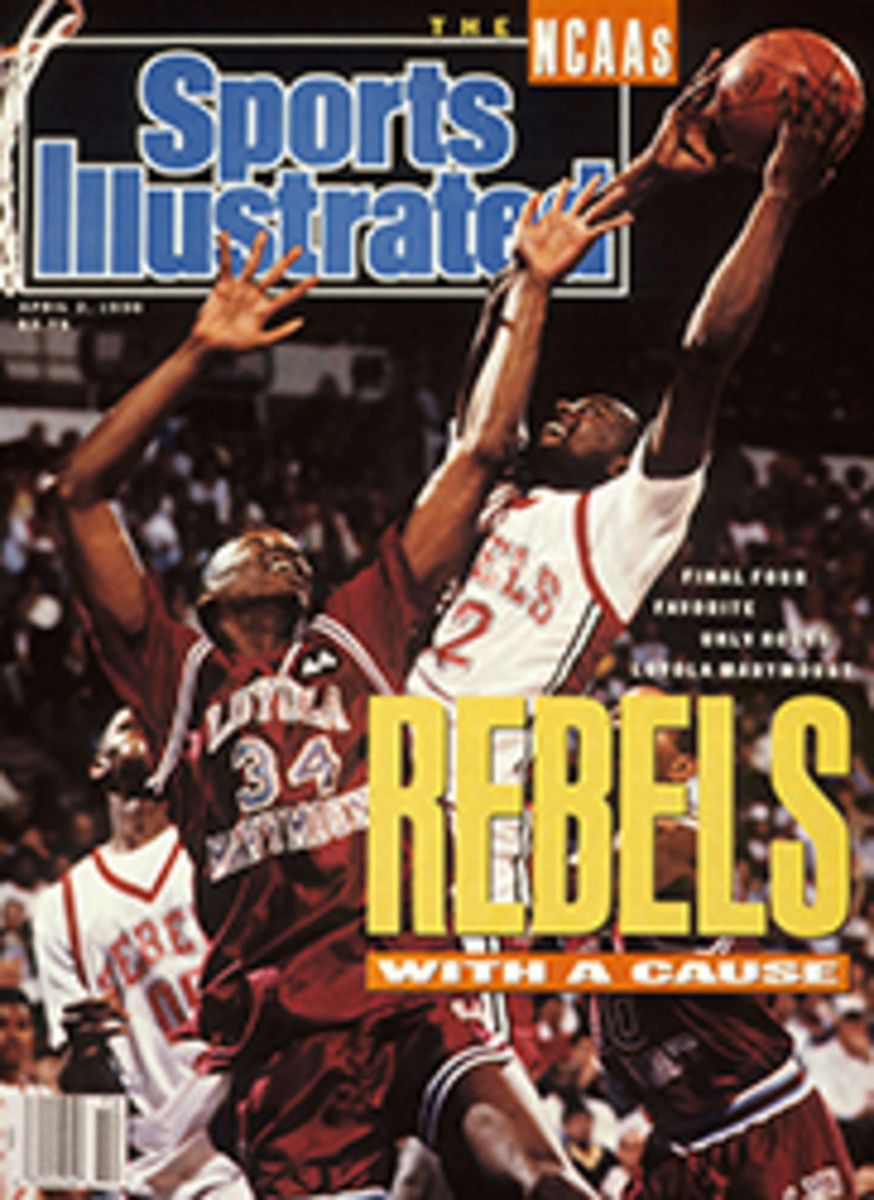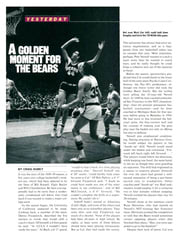
A GOLDEN MOMENT FOR THE BEARS
It was the start of the 1958-59 season, a few years into college basketball's modern era, which had been ushered in by the likes of Bill Russell, Elgin Baylor and Wilt Chamberlain. By then you supposedly had to be more than a moderately coordinated tall fellow who tried hard if you wanted to make a major college team.
As the season began, the University of California appeared to be weak. Looking back, a member of the team, Denny Fitzpatrick, described the five starters in words that would chill a coach's heart. Of himself, a 6-foot guard, he said, "At UCLA I wouldn't have made the team." Al Buch, a 6'2" guard, "would've had a heck of a time playing anyplace else." Darrall Imhoff, the 6'10" center, "could hardly walk when he came to Cal." Of Bob Dalton, a 6'3" forward, Fitzpatrick said, "I doubt he could have made any one of the other teams in our conference," and of Bill McClintock, a 6'4" forward, "He couldn't complete the drills as a sophomore. He couldn't do it."
Imhoff hadn't started at Alhambra (Calif.) High, and most of the others had been only so-so schoolboy players. They were slow, and only Fitzpatrick was much of a shooter. None of the players had been all-state in high school. By rights, at least some of these fellows should have been playing intramurals. But at Cal, they had made the varsity. The university has always had strict entrance requirements, and as it happened, little raw basketball talent was on campus that year. Most important, perhaps, Pete Newell wanted to coach a team more than he wanted to coach stars, and he really thought he could forge a cohesive unit out of the material at hand.
Before the season, sportswriters predicted that Cal would finish in the lower half of the nine-team Pacific Coast Conference, the Pac-10's predecessor, although one brave writer did rank the Golden Bears fourth. But the scribes were selling the 43-year-old Newell short. In 1949 he had coached unheralded San Francisco to the NIT championship—then the premier postseason basketball tournament—and he later coached at Michigan State for four seasons before going to Berkeley in 1954. He had more or less invented the full-court press, the four-corners stall and the concept of making your big guys play near the basket not only on offense but also on defense.
Newell also emphasized conditioning. During practices at Harmon Gym, he would subject his players to the "hands up" drill. Newell would stand under the basket and command, "Forward, left, back, right, left, forward...." The players would follow his directions, while keeping one hand, the same hand, in the air as though they were guarding an opponent. The drill had originated as a means to improve players' footwork but over the years had gained a well-earned reputation of being a gut-buster second only to windsprints. Other coaches used "hands up" too. Real taskmasters would employ it for a torturous two to four minutes without stopping. Newell worked his players that way for 20 minutes.
Newell chose as his assistant coach Rene Herrerias, who had starred on Newell's NIT-winning San Francisco team. Herrerias scouted the competition so well that the Bears would sometimes correct opposing players when they botched their plays: "Hey, you were supposed to go to the baseline!"
Despite their lack of talent, Cal won the PCC with a 14-2 record and finished 21-4 overall. The Bears beat UCLA twice (when Newell gave up coaching a year later to become athletic director, he had eight straight wins over Bruin coach John Wooden) and led the nation in defense, yielding an average of 51.0 points a game. In the Western regionals, the Bears routed Utah 71-53 and their Bay Area neighbors St. Mary's 66-46. Just four days later, on March 18, they found themselves traveling to the Final Four, held that year at the Kentucky Fair and Exposition Center in Louisville. Despite their formidable record, they were still unknowns from out West, an area then lightly regarded in the sport. Sports-writers denigrated Cal, one of them referring to Imhoff and his teammates as "a horse and four dogs."
The tournament was sure to be won by Louisville, Cincinnati or West Virginia, the other three finalists. Cincinnati featured Oscar Robertson, who led the country in scoring, with 32.6 points per game. West Virginia's mainstay was Jerry West, whose 26.6 scoring average was fifth in the nation.
Newell had coached the Bears to be confident, even relaxed. Before their semifinal, against Cincinnati, Dalton, Cal's pencil-thin forward, walked onto the floor, approached Robertson and said, "Hi, my name's Dalton. What's yours?" Dalton and sub Jack Grout then held Robertson to 19 points, allowing him to score just one field goal in the second half. Imhoff scored 22 points; Buch, 18. It was the upset of the year: California 64, Cincinnati 58.
The victory was considered a fluke, and most observers expected the Bears to be put in their place by West Virginia, which, behind West's 38 points, had blown out Louisville 94-79 in the other semi. Interest in the final game was intense—the No. 1 defense against the No. 2 offense (84.8 points a game), a bunch of nobodies from the West against a guy named West. In Hamilton, Ohio, legend has it, a corrections officer announced to inmates in the county jail that if a stolen billy club was not turned in, they would not get to watch the finals on TV The missing club was returned—as were four others, plus three hacksaws.
In the first 10 minutes, West Virginia rocketed to a 23-13 lead. Newell substituted Grout, Bernie Simpson and Dick Doughty for McClintock, Buch and Imhoff. Using a tight press, the Bears forced error after error by the Mountaineers, and within four minutes they had tied the game 25-25. At halftime Cal led 39-33.
In the second half it was the Bears who staged a run in the early going as they built their lead to 13 points. But with 10 minutes left, West Virginia went into a full-court press. Now it was Cal that began to commit errors and turnovers. With 51 seconds to go, the Mountaineers had narrowed the margin to 69-68.
Cal passed the ball around, looking for a safe shot. Dalton bounce-passed to Imhoff. The big center wheeled for a hook from six feet away. In!
...And out.
The ball spun off the rim and back to Imhoff. He leaped and tapped it toward the hoop. In! And this time, through—two points. The Mountaineers scored a field goal in the last 17 seconds, but the game ended 71-70 with the ball in West's hands, a court-length from any chance at victory.
Newell was carried around the floor by his players, and Cal fans, band members and pom-pom girls hugged and kissed everyone in reach. Along press row there was satisfaction with the outcome. "Cal deserved it," said more than one writer. All agreed the Bears had won because they'd played as a team.
Three decades later, they are still a team. Everyone stays in touch, and everyone is there if any player is in need. At five-year intervals, members of the team gather for reunions, the highlight of which is a full-tilt, full-court game. Most of the players look as if they're ready to play West Virginia again.
Eighteen of the 19 members of the 1958-59 team graduated. Imhoff is now a successful businessman and, even after a 12-year NBA career, is working on the final three credit hours toward his degree in forestry. Newell was Cal's athletic director until 1968. He coached the 1960 U.S. Olympic team, which won the gold medal, and went on to coach countless coaches about coaching. He now makes his home in the Los Angeles suburb of Palos Verdes and is a consultant and West Coast scout for the Cleveland Cavaliers. Bobby Knight said of Newell, "He has the best all-around grasp of the game of anyone I've ever been around."
Those who played for Newell at Cal revere him, and they are just a few of the players and coaches and fans who hold him in the highest esteem. "You could fill this place with the friends of Pete Newell," said a former Golden Bear. At the time, he was standing outside the Los Angeles Coliseum.
PHOTO
MARVIN E. NEWMAN
Not even West (far left) could hold down Doughty and Cal in the '59 NCAA title game.
PHOTO
AP
Newell knew how to turn run-of-the-mill players into national champions.
Craig Kubey, a former Cal student, now lives and writes in Davis, Calif.

